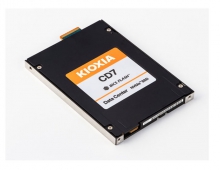
HP Confirms Plans for Blu-ray
HP has firmed up its plans for Blu-ray DVD disk drives and said the format would begin going into many of its product lines, including select consumer desktop and notebook PCs, personal workstations and digital entertainment centers.
The company adds it will continue to work with the other companies of the Blu-Ray Disc (we say Disk) Association to complete the format technology and develop the drives and will introduce them in late 2005 - initially in media center PCs, desktop PCs, personal workstations and digital entertainment devices followed by notebooks in early 2006.
The technology enables the recording, rewriting and playback of high-definition (HD) video, as well as the ability to store immense amounts of data, up to 50 gigabytes on a single dual-layer disk, enough to record 26 hours of standard definition television and eight hours of HDTV.
Blu-ray remains in a fight for its existence with the DVD Forum's HD DVD, which uses the same basic technology and which was initially embraced by over 200 members of the DVD forum last year when the NEC/Toshiba technology proposal was accepted. Since that decision, however, the great bulk of the big consumer electronics firms, including Philips, Sony and Panasonic, have come out in favor of Blu-ray, which is expected to arrive earlier than the competing standard. It was proposed by Sony and Panasonic.
The decision by Dell and HP back in January to support it went a long way to convincing (so far) 73 organizations to back Blu-ray, since it will now be in most PCs. So far, only Microsoft has added its weight to the HD DVD in the last few months, in more of a futile anti-Sony move than any real resistance, saying that Longhorn would support HD DVD only (which of course it won't because you support it at the driver level and the hardware firms write those).
Blu-ray disks will arrive with three different media types at launch, BD-ROM a read only version, for software, games and movie distribution; BD-RE, a rewritable format for HDTV recording and data storage; and BD-R, a write-once format for HDTV recording and data storage.
Hewlett-Packard also said that its drives will also include LightScribe technology, a labeling system developed by HP that allows silkscreen quality text and graphics to be burned directly onto LightScribe-enabled Blu-ray disks using the same laser that burns to the data side of the disk."
The technology enables the recording, rewriting and playback of high-definition (HD) video, as well as the ability to store immense amounts of data, up to 50 gigabytes on a single dual-layer disk, enough to record 26 hours of standard definition television and eight hours of HDTV.
Blu-ray remains in a fight for its existence with the DVD Forum's HD DVD, which uses the same basic technology and which was initially embraced by over 200 members of the DVD forum last year when the NEC/Toshiba technology proposal was accepted. Since that decision, however, the great bulk of the big consumer electronics firms, including Philips, Sony and Panasonic, have come out in favor of Blu-ray, which is expected to arrive earlier than the competing standard. It was proposed by Sony and Panasonic.
The decision by Dell and HP back in January to support it went a long way to convincing (so far) 73 organizations to back Blu-ray, since it will now be in most PCs. So far, only Microsoft has added its weight to the HD DVD in the last few months, in more of a futile anti-Sony move than any real resistance, saying that Longhorn would support HD DVD only (which of course it won't because you support it at the driver level and the hardware firms write those).
Blu-ray disks will arrive with three different media types at launch, BD-ROM a read only version, for software, games and movie distribution; BD-RE, a rewritable format for HDTV recording and data storage; and BD-R, a write-once format for HDTV recording and data storage.
Hewlett-Packard also said that its drives will also include LightScribe technology, a labeling system developed by HP that allows silkscreen quality text and graphics to be burned directly onto LightScribe-enabled Blu-ray disks using the same laser that burns to the data side of the disk."





















